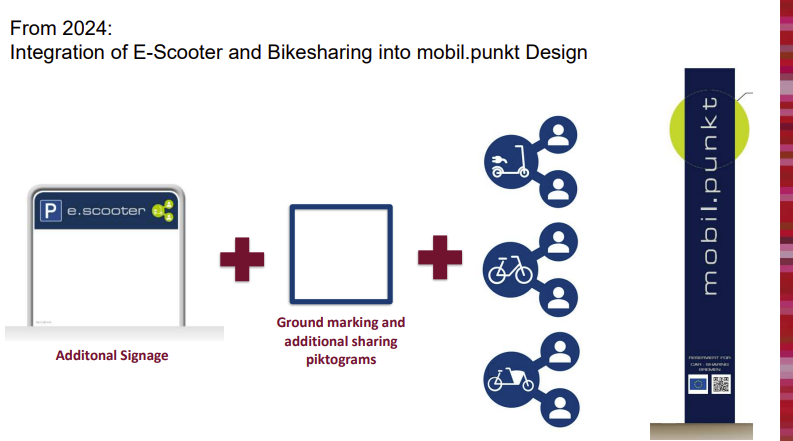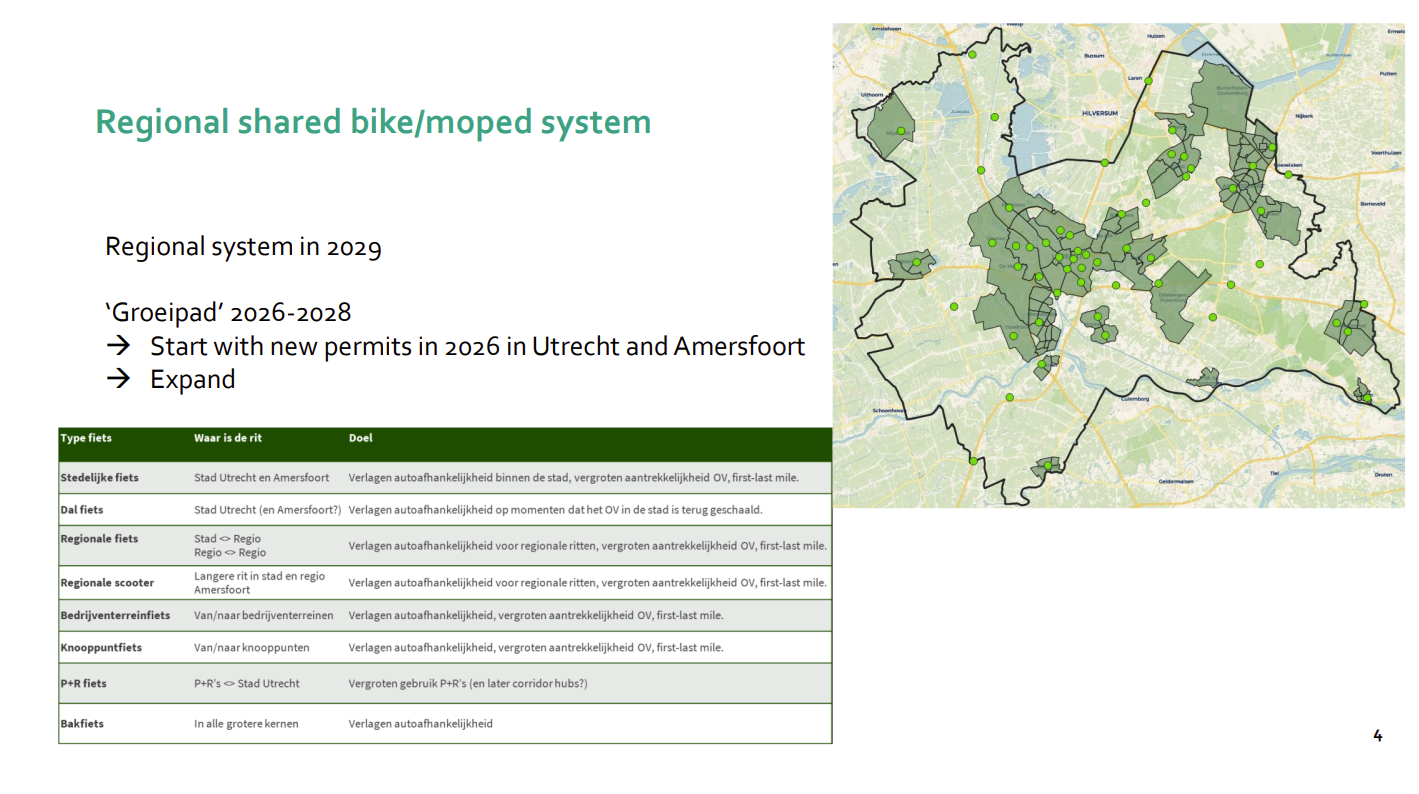As the project arrives to its 2-year mark, this thematic meeting put the focus on the upscaling of shared mobility solutions and mobility hubs.
As part of the Shared and Digital Mobility Hubs (SDMH) project, partners gather regularly to focus on a topic and discuss with external experts, operators and cities the best solutions for shared mobility. Upscaling shared mobility strategies is one of the main goals for some of the pilot of ShareDiMobiHub. Not only that, based on the learnings from the experiences of the partners implementing upscaling action plans, some other partners such as Rotterdam, the province of Utrecht and the Capital Region of Denmark, will draft and adopt each an upscaling strategy to rollout shared mobility hubs.
Insights from outside the SDMH project
A new way to rethink mobility tenders
Erdem Ovacik, from impact-market.org, opened the meeting by presenting his innovative Impact Market Approach, which provides a dynamic and adaptable financial model for cities looking to scale new mobility solutions. Traditional models such as tenders, he argued, often fail to deliver flexibility and adaptability, delaying the launch of services and complicating expansions. Erdem highlighted the challenges cities face, such as congestion, emissions, and lack of physical exercise, and how different modes of transport, from bikes to e-cargo bikes and shared cars, can address these issues.
Erdem’s models is simple, cities pay operators based on the actual mobility impact they generate. This dynamic model, he explained, allows cities to support mobility solutions based on real-time data about trips, congestion reduction, carbon emissions saved, and health impacts. By enabling monthly revisions of both funding commitments and performance metrics, this model offers cities a more adaptable and transparent way to manage and scale mobility services while addressing the diverse needs of different neighbourhoods, from dense urban centres to low-income areas.
Antwerp innovative approach and expansion to suburban areas
Jelle de Keyser, representing the City of Antwerp, provided insights into the city’s rapidly expanding shared micromobility network. Antwerp has seen substantial growth in bike and scooter-sharing systems, with an emphasis on free-floating services. Jelle explained that Antwerp’s success has been driven by the strategic use of geofencing and monitoring systems to ensure that micromobility services do not overwhelm certain areas while remaining accessible in under-served regions. Data is a critical factor in this approach, enabling the city to adjust service levels and fleet sizes dynamically.
In addition, Antwerp has introduced licensing for shared micromobility services, ensuring a balanced distribution of bikes and scooters across the city. Donkey Republic, a shared bike service, has been particularly successful, contributing to a modal shift towards more sustainable transport. Jelle concluded by highlighting the importance of continuous monitoring and data collection to optimise operations and prepare for further upscaling.
Bremen and their efforts to include shared mobility with real estate development
Rebecca Karbaumer from the City of Bremen presented Bremen’s approach to car-sharing and mobility hubs, which has become a model for cities across Germany. Bremen, known for having the first car-sharing station in public space in Germany, continues to lead in innovation with over 150 car-sharing stations, including 51 in the public realm. Rebecca shared the city’s strategy of integrating car-sharing into urban planning and real estate development, through the Interreg North-Sea Region project SHARE-North Squared, where developers are required to incorporate mobility hubs into new projects. This approach has significantly reduced the need for private car ownership, with over 27,700 active car-sharing users in the city.
Bremen’s mobil.punkt hubs are key to the city’s strategy, allowing residents to easily switch from public transport to shared cars, bikes, and scooters. Rebecca emphasised the importance of public awareness campaigns to make car-sharing more visible and accessible, particularly in economically disadvantaged areas where the city provides temporary subsidies to encourage adoption. Moving forward, Bremen plans to integrate e-scooters and bike-sharing into its mobil.punkt infrastructure, expanding the range of shared mobility options available to residents.

Upscaling approaches from the project consortium
Utrecht regional vision for shared mobility
The second half of the meeting focused on upscaling efforts within the project consortium. The Province of Utrecht shared its comprehensive approach to upscaling shared mobility hubs and integrating Mobility as a Service (MaaS). Utrecht’s plan centres on the development of a regional shared bike and moped system, aiming to fully implement this by 2029. The roadmap begins with new permits for shared mobility operators in Utrecht and Amersfoort by 2026, and the region is exploring whether to adopt a national identity system for shared mobility, which could streamline expansion efforts across municipalities.
Additionally, Utrecht is working to make mobility hubs publicly accessible, expanding the availability of shared mobility options across the region. Their efforts to use national identity systems for all municipalities will ensure a unified and cohesive approach to scaling shared mobility across the region.

Amsterdam expanding their shared mobility horizons
Finally, representatives from the City of Amsterdam and the Amsterdam Transport Authority discussed their collaborative efforts to scale up shared mobility hubs across the city. The discussion centred on aligning mobility hubs with the city’s broader public transport network, ensuring that shared mobility options complement existing services and contribute to the city's long-term sustainability goals.
Finally, Angelique Akkerman from the City of Amsterdam shared their plans to upscale neighbourhood hubs and create a citywide and regional network of mobility hubs. The focus is twofold: firstly, on areas of the city that are very busy and face a high demand for space, which necessitates greater regulation to accommodate shared mobility options. Secondly, they are concentrating on underserved areas that currently lack access to shared mobility services, with the aim of reaching new target groups and ensuring that shared mobility is available for everyone.
In terms of infrastructure, Amsterdam is prioritising the development of a strong data infrastructure and standardisation efforts. These are critical for establishing a robust monitoring system that can operate on both tactical and strategic levels, allowing for real-time adjustments and long-term planning. On the digital side, the city is aiming for level 4 MaaS (Mobility as a Service) integration, which will provide seamless digital connectivity between different modes of transport, enabling users to plan and pay for journeys across the city effortlessly.
Conclusion
The meeting concluded with an engaging discussion where participants exchanged insights on the challenges and opportunities related to the upscaling of shared mobility. Topics included the importance of robust data management, the need for supportive regulatory frameworks, and the critical role of public engagement in promoting the adoption of new mobility services. The diverse experiences shared by Antwerp, Bremen, Utrecht, and Amsterdam provided valuable perspectives on how cities can successfully scale their shared mobility solutions. As these efforts progress, the results and findings from the project pilots and strategies will be shared soon, offering further insights into effective upscaling practices across different regions.
